Abstract
The pneumocandins are natural lipopeptide products of the echinocandin class which inhibit the synthesis of 1,3-beta-D-glucan in susceptible fungi. The lack of a corresponding pathway in mammalian hosts makes this mode of action an attractive one for treating systemic infections. Substitution by an aminoethyl ether at the hemiaminal and dehydration and reduction of the glutamine of pneumocandin B0 produced a semisynthetic compound (L-733,560) with intrinsic water solubility, significantly increased potency, and a broader antifungal spectrum. To evaluate the mechanism for the improved antifungal efficacy, we determined that L-733,560 was a more potent inhibitor of glucan synthase activity in vitro, did not affect the other membrane-bound enzymes tested, conferred susceptibility to lysis in the absence of osmotic support, and did not disrupt currents in liposomal bilayers or 86Rb+ fluxes from liposomes. In Aspergillus species L-733,560 also produced the same morphological alterations as pneumocandin B0. A stereoisomer of L-733,560 with poor antifungal activity was a weak inhibitor of glucan synthase. All of these results support the notion that the enhanced antifungal activity of L-733,560 is achieved by superior inhibition of glucan synthesis and not by nonspecific membrane effects or a second mode of action.
Full text
PDF
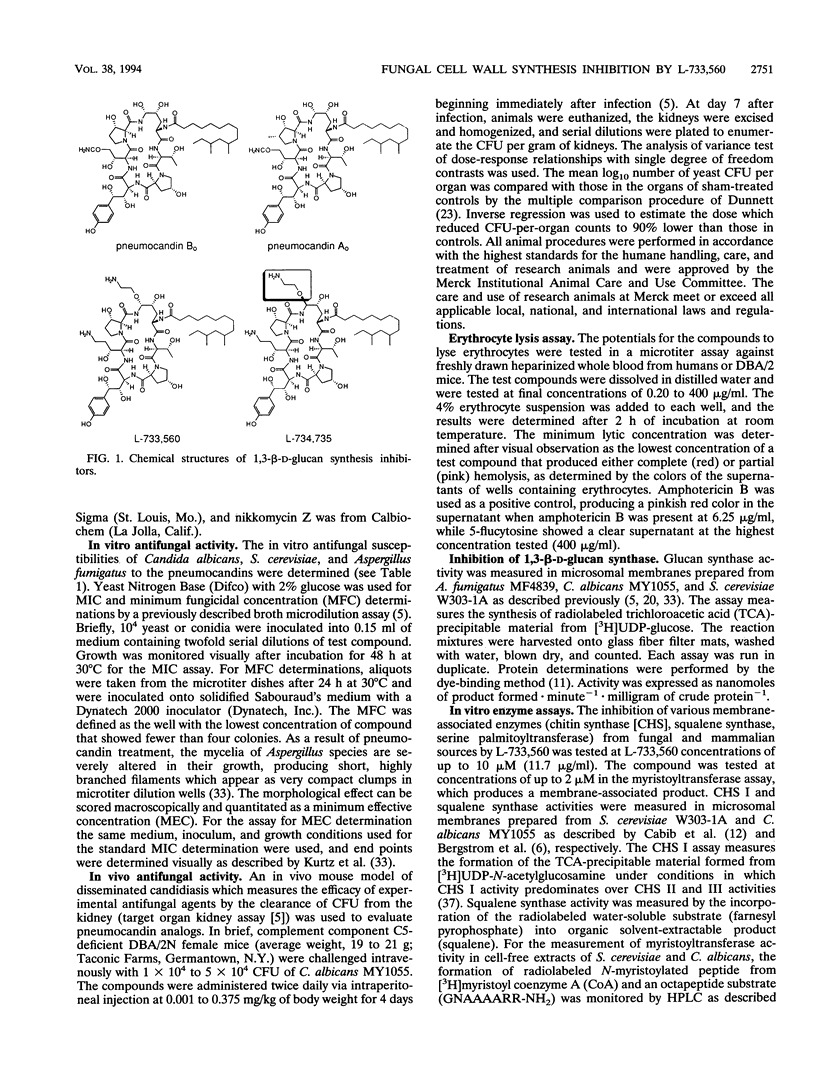
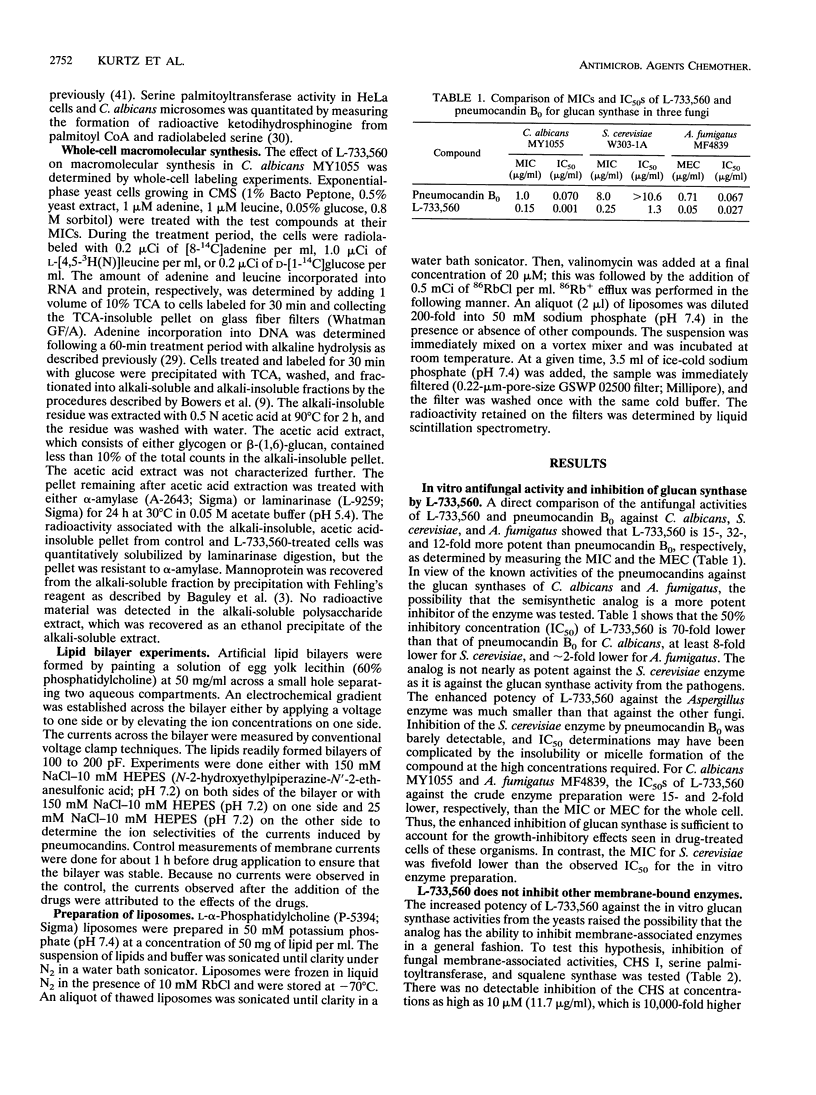

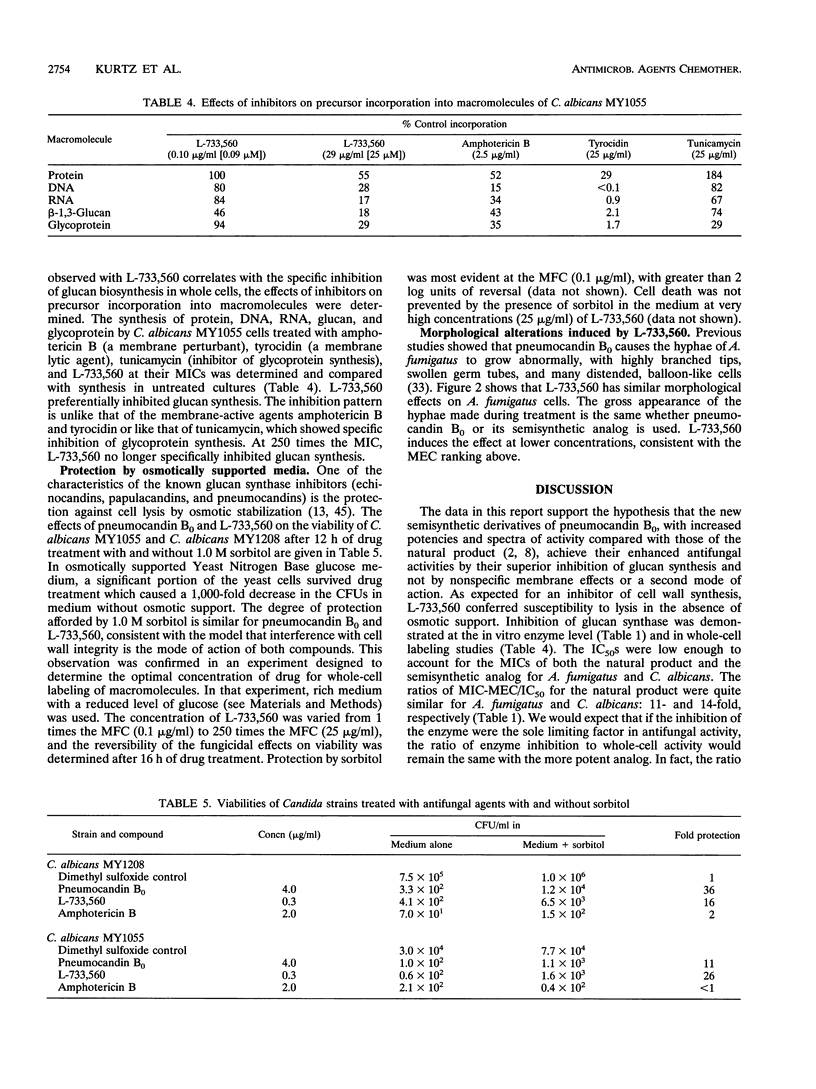
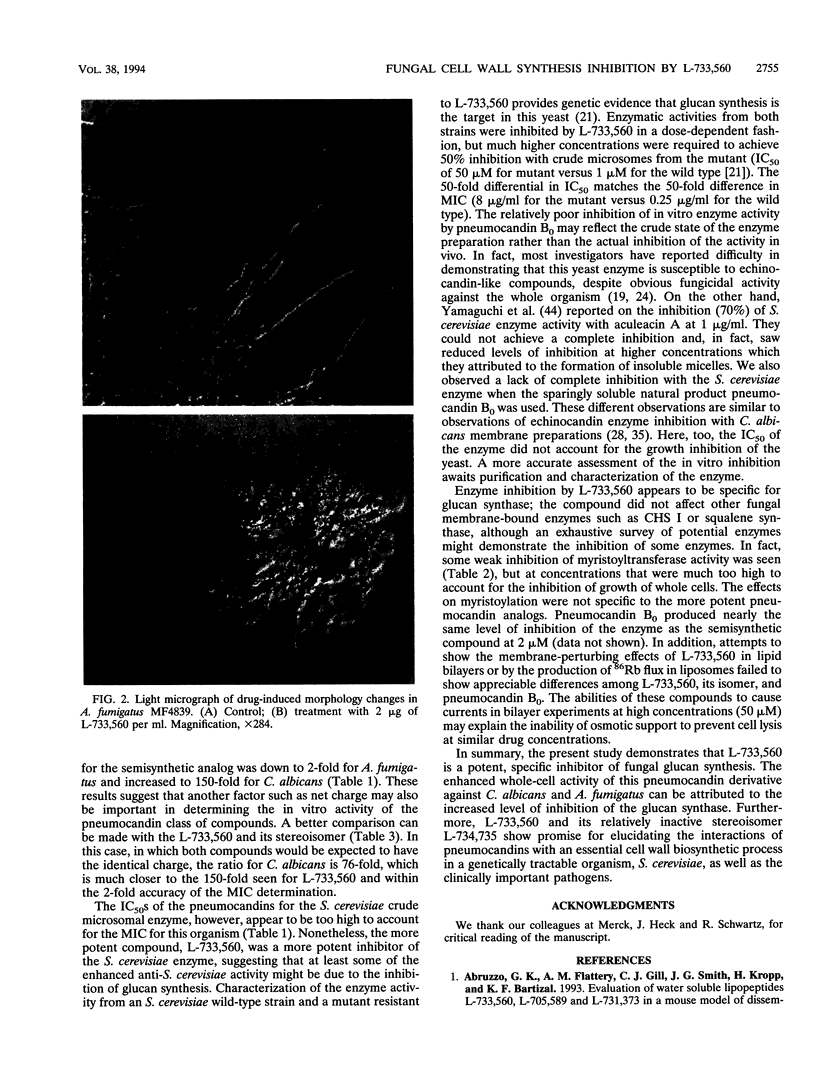
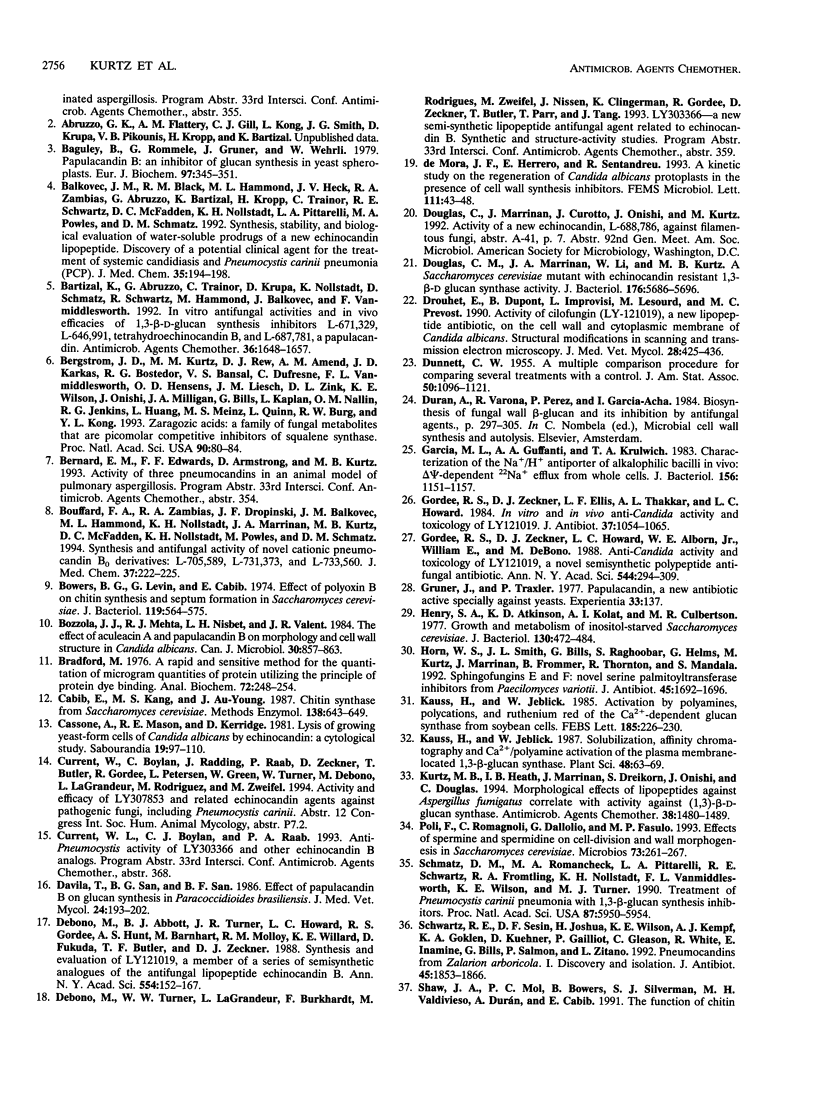

Images in this article
Selected References
These references are in PubMed. This may not be the complete list of references from this article.
- Baguley B. C., Römmele G., Gruner J., Wehrli W. Papulacandin B: an inhibitor of glucan synthesis in yeast spheroplasts. Eur J Biochem. 1979 Jul;97(2):345–351. doi: 10.1111/j.1432-1033.1979.tb13120.x. [DOI] [PubMed] [Google Scholar]
- Balkovec J. M., Black R. M., Hammond M. L., Heck J. V., Zambias R. A., Abruzzo G., Bartizal K., Kropp H., Trainor C., Schwartz R. E. Synthesis, stability, and biological evaluation of water-soluble prodrugs of a new echinocandin lipopeptide. Discovery of a potential clinical agent for the treatment of systemic candidiasis and Pneumocystis carinii pneumonia (PCP). J Med Chem. 1992 Jan;35(1):194–198. doi: 10.1021/jm00079a027. [DOI] [PubMed] [Google Scholar]
- Bartizal K., Abruzzo G., Trainor C., Krupa D., Nollstadt K., Schmatz D., Schwartz R., Hammond M., Balkovec J., Vanmiddlesworth F. In vitro antifungal activities and in vivo efficacies of 1,3-beta-D-glucan synthesis inhibitors L-671,329, L-646,991, tetrahydroechinocandin B, and L-687,781, a papulacandin. Antimicrob Agents Chemother. 1992 Aug;36(8):1648–1657. doi: 10.1128/aac.36.8.1648. [DOI] [PMC free article] [PubMed] [Google Scholar]
- Bergstrom J. D., Kurtz M. M., Rew D. J., Amend A. M., Karkas J. D., Bostedor R. G., Bansal V. S., Dufresne C., VanMiddlesworth F. L., Hensens O. D. Zaragozic acids: a family of fungal metabolites that are picomolar competitive inhibitors of squalene synthase. Proc Natl Acad Sci U S A. 1993 Jan 1;90(1):80–84. doi: 10.1073/pnas.90.1.80. [DOI] [PMC free article] [PubMed] [Google Scholar]
- Bouffard F. A., Zambias R. A., Dropinski J. F., Balkovec J. M., Hammond M. L., Abruzzo G. K., Bartizal K. F., Marrinan J. A., Kurtz M. B., McFadden D. C. Synthesis and antifungal activity of novel cationic pneumocandin B(o) derivatives. J Med Chem. 1994 Jan 21;37(2):222–225. doi: 10.1021/jm00028a003. [DOI] [PubMed] [Google Scholar]
- Bowers B., Levin G., Cabib E. Effect of polyoxin D on chitin synthesis and septum formation in Saccharomyces cerevisiae. J Bacteriol. 1974 Aug;119(2):564–575. doi: 10.1128/jb.119.2.564-575.1974. [DOI] [PMC free article] [PubMed] [Google Scholar]
- Bozzola J. J., Mehta R. J., Nisbet L. J., Valenta J. R. The effect of aculeacin A and papulacandin B on morphology and cell wall ultrastructure in Candida albicans. Can J Microbiol. 1984 Jun;30(6):857–863. doi: 10.1139/m84-133. [DOI] [PubMed] [Google Scholar]
- Bradford M. M. A rapid and sensitive method for the quantitation of microgram quantities of protein utilizing the principle of protein-dye binding. Anal Biochem. 1976 May 7;72:248–254. doi: 10.1006/abio.1976.9999. [DOI] [PubMed] [Google Scholar]
- Cabib E., Kang M. S., Au-Young J. Chitin synthase from Saccharomyces cerevisiae. Methods Enzymol. 1987;138:643–649. doi: 10.1016/0076-6879(87)38058-9. [DOI] [PubMed] [Google Scholar]
- Cassone A., Mason R. E., Kerridge D. Lysis of growing yeast-form cells of Candida albicans by echinocandin: a cytological study. Sabouraudia. 1981 Jun;19(2):97–110. [PubMed] [Google Scholar]
- Debono M., Abbott B. J., Turner J. R., Howard L. C., Gordee R. S., Hunt A. S., Barnhart M., Molloy R. M., Willard K. E., Fukuda D. Synthesis and evaluation of LY121019, a member of a series of semisynthetic analogues of the antifungal lipopeptide echinocandin B. Ann N Y Acad Sci. 1988;544:152–167. doi: 10.1111/j.1749-6632.1988.tb40398.x. [DOI] [PubMed] [Google Scholar]
- Drouhet E., Dupont B., Improvisi L., Lesourd M., Prevost M. C. Activity of cilofungin (LY 121019), a new lipopeptide antibiotic, on the cell wall and cytoplasmic membrane of Candida albicans. Structural modifications in scanning and transmission electron microscopy. J Med Vet Mycol. 1990;28(6):425–436. doi: 10.1080/02681219080000541. [DOI] [PubMed] [Google Scholar]
- Dávila T., San-Blas G., San-Blas F. Effect of papulacandin B on glucan synthesis in Paracoccidioides brasiliensis. J Med Vet Mycol. 1986 Jun;24(3):193–202. [PubMed] [Google Scholar]
- Font de Mora J., Herrero E., Sentandreu R. A kinetic study on the regeneration of Candida albicans protoplasts in the presence of cell wall synthesis inhibitors. FEMS Microbiol Lett. 1993 Jul 15;111(1):43–47. doi: 10.1111/j.1574-6968.1993.tb06359.x. [DOI] [PubMed] [Google Scholar]
- Garcia M. L., Guffanti A. A., Krulwich T. A. Characterization of the Na+/H+ antiporter of alkalophilic bacilli in vivo: delta psi-dependent 22Na+ efflux from whole cells. J Bacteriol. 1983 Dec;156(3):1151–1157. doi: 10.1128/jb.156.3.1151-1157.1983. [DOI] [PMC free article] [PubMed] [Google Scholar]
- Gordee R. S., Zeckner D. J., Ellis L. F., Thakkar A. L., Howard L. C. In vitro and in vivo anti-Candida activity and toxicology of LY121019. J Antibiot (Tokyo) 1984 Sep;37(9):1054–1065. doi: 10.7164/antibiotics.37.1054. [DOI] [PubMed] [Google Scholar]
- Gordee R. S., Zeckner D. J., Howard L. C., Alborn W. E., Jr, Debono M. Anti-Candida activity and toxicology of LY121019, a novel semisynthetic polypeptide antifungal antibiotic. Ann N Y Acad Sci. 1988;544:294–309. doi: 10.1111/j.1749-6632.1988.tb40415.x. [DOI] [PubMed] [Google Scholar]
- Henry S. A., Atkinson K. D., Kolat A. I., Culbertson M. R. Growth and metabolism of inositol-starved Saccharomyces cerevisiae. J Bacteriol. 1977 Apr;130(1):472–484. doi: 10.1128/jb.130.1.472-484.1977. [DOI] [PMC free article] [PubMed] [Google Scholar]
- Horn W. S., Smith J. L., Bills G. F., Raghoobar S. L., Helms G. L., Kurtz M. B., Marrinan J. A., Frommer B. R., Thornton R. A., Mandala S. M. Sphingofungins E and F: novel serinepalmitoyl transferase inhibitors from Paecilomyces variotii. J Antibiot (Tokyo) 1992 Oct;45(10):1692–1696. doi: 10.7164/antibiotics.45.1692. [DOI] [PubMed] [Google Scholar]
- Kurtz M. B., Heath I. B., Marrinan J., Dreikorn S., Onishi J., Douglas C. Morphological effects of lipopeptides against Aspergillus fumigatus correlate with activities against (1,3)-beta-D-glucan synthase. Antimicrob Agents Chemother. 1994 Jul;38(7):1480–1489. doi: 10.1128/aac.38.7.1480. [DOI] [PMC free article] [PubMed] [Google Scholar]
- Poli F., Romagnoli C., Dall'Olio G., Fasulo M. P. Effects of spermine and spermidine on cell division and wall morphogenesis in Saccharomyces cerevisiae. Microbios. 1993;73(297):261–267. [PubMed] [Google Scholar]
- Schmatz D. M., Romancheck M. A., Pittarelli L. A., Schwartz R. E., Fromtling R. A., Nollstadt K. H., Vanmiddlesworth F. L., Wilson K. E., Turner M. J. Treatment of Pneumocystis carinii pneumonia with 1,3-beta-glucan synthesis inhibitors. Proc Natl Acad Sci U S A. 1990 Aug;87(15):5950–5954. doi: 10.1073/pnas.87.15.5950. [DOI] [PMC free article] [PubMed] [Google Scholar]
- Schwartz R. E., Sesin D. F., Joshua H., Wilson K. E., Kempf A. J., Goklen K. A., Kuehner D., Gailliot P., Gleason C., White R. Pneumocandins from Zalerion arboricola. I. Discovery and isolation. J Antibiot (Tokyo) 1992 Dec;45(12):1853–1866. doi: 10.7164/antibiotics.45.1853. [DOI] [PubMed] [Google Scholar]
- Shaw J. A., Mol P. C., Bowers B., Silverman S. J., Valdivieso M. H., Durán A., Cabib E. The function of chitin synthases 2 and 3 in the Saccharomyces cerevisiae cell cycle. J Cell Biol. 1991 Jul;114(1):111–123. doi: 10.1083/jcb.114.1.111. [DOI] [PMC free article] [PubMed] [Google Scholar]
- Taft C. S., Selitrennikoff C. P. LY121019 inhibits Neurospora crassa growth and (1-3)-beta-D-glucan synthase. J Antibiot (Tokyo) 1988 May;41(5):697–701. doi: 10.7164/antibiotics.41.697. [DOI] [PubMed] [Google Scholar]
- Taft C. S., Stark T., Selitrennikoff C. P. Cilofungin (LY121019) inhibits Candida albicans (1-3)-beta-D-glucan synthase activity. Antimicrob Agents Chemother. 1988 Dec;32(12):1901–1903. doi: 10.1128/aac.32.12.1901. [DOI] [PMC free article] [PubMed] [Google Scholar]
- Towler D. A., Adams S. P., Eubanks S. R., Towery D. S., Jackson-Machelski E., Glaser L., Gordon J. I. Myristoyl CoA:protein N-myristoyltransferase activities from rat liver and yeast possess overlapping yet distinct peptide substrate specificities. J Biol Chem. 1988 Feb 5;263(4):1784–1790. [PubMed] [Google Scholar]
- VanMiddlesworth F., Omstead M. N., Schmatz D., Bartizal K., Fromtling R., Bills G., Nollstadt K., Honeycutt S., Zweerink M., Garrity G. L-687,781, a new member of the papulacandin family of beta-1,3-D-glucan synthesis inhibitors. I. Fermentation, isolation, and biological activity. J Antibiot (Tokyo) 1991 Jan;44(1):45–51. doi: 10.7164/antibiotics.44.45. [DOI] [PubMed] [Google Scholar]
- Wichmann C. F., Liesch J. M., Schwartz R. E. L-671,329, a new antifungal agent. II. Structure determination. J Antibiot (Tokyo) 1989 Feb;42(2):168–173. doi: 10.7164/antibiotics.42.168. [DOI] [PubMed] [Google Scholar]
- Yamaguchi H., Hiratani T., Baba M., Osumi M. Effect of aculeacin A, a wall-active antibiotic, on synthesis of the yeast cell wall. Microbiol Immunol. 1985;29(7):609–623. doi: 10.1111/j.1348-0421.1985.tb00865.x. [DOI] [PubMed] [Google Scholar]
- Yamaguchi H., Hiratani T., Iwata K., Yamamoto Y. Studies on the mechanism of antifungal action of aculeacin A. J Antibiot (Tokyo) 1982 Feb;35(2):210–219. doi: 10.7164/antibiotics.35.210. [DOI] [PubMed] [Google Scholar]



